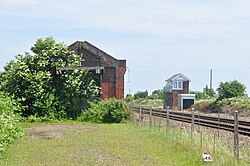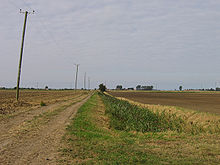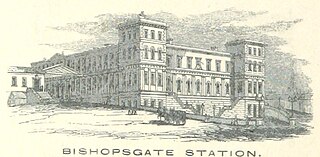
Bishopsgate was a railway station located on the eastern side of Shoreditch High Street in the parish of Bethnal Green on the western edge of the East End of London and just outside the City of London.

Cheshunt is a National Rail and London Overground station in Cheshunt, Hertfordshire, England. On the National Rail network it is on the West Anglia Main Line, 14 miles 1 chain (22.6 km) from London Liverpool Street and situated between Waltham Cross and Broxbourne. On the London Overground network it is one of three northern termini of the Lea Valley lines.
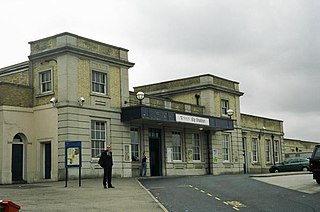
Ely railway station is on the Fen line in the east of England, serving the city of Ely, Cambridgeshire. It is 70 miles 30 chains (113.3 km) from London Liverpool Street and is situated between Waterbeach and Littleport stations on the Fen line to King's Lynn. It is an important junction for three other lines; the Ely to Peterborough Line, the Ipswich to Ely Line and the Norwich to Ely line.

The Ipswich–Ely line is a railway line linking East Anglia to the English Midlands via Ely. There is also a branch line to Cambridge. Passenger services are operated by Abellio Greater Anglia. It is a part of Network Rail Strategic Route 5, SRS 05.07, 05.08 and part of SRS 07.03. The line has previously been part of the Great Eastern Main Line.
Benwick is a village and civil parish in the Fenland district of Cambridgeshire, England. It is approximately 15 miles (24 km) from Peterborough and 30 miles (48 km) from Cambridge. The population of Benwick was recorded as 1137 in the United Kingdom Census 2011 with 452 households. The River Nene passes through the village, which is thus accessible by boat from the inland waterways network in England.

Bow was a railway station in Bow, east London, that was opened in 1850 by the East & West India Docks and Birmingham Junction Railway, which was later renamed the North London Railway (NLR). The station was situated between Old Ford and South Bromley, and was located on the north side of Bow Road, close to the second Bow Road station which was open from 1892 to 1949. A covered footway connected the two stations between 1892 and 1917.
The Kelvedon and Tollesbury Light Railway was a locally promoted railway company, intended to open up an agricultural district that suffered from poor transport links. The enactment of the Light Railways Act 1896 encouraged the promoters to persuade the dominant main line railway, the Great Eastern Railway (GER), to participate in the construction and operation of the line.

The Wisbech and Upwell Tramway was a rural standard gauge tramway in East Anglia. It was built by the Great Eastern Railway between Wisbech, Isle of Ely, Cambridgeshire and Upwell, now in Norfolk to carry agricultural produce. Although called a tramway, in many ways it more closely resembled a conventional railway line, and paved the way for the passing of the Light Railways Act 1896.

The East Kent Light Railway was part of the Colonel Stephens group of cheaply built rural light railways in England. Holman Fred Stephens was engineer from its inception, subsequently becoming director and manager. The line ran from Shepherdswell to Wingham Station with a branch from Eastry through Poison Cross to Richborough Port. Built primarily for colliery traffic within the Kent Coalfields, the line was built with many spurs and branches to serve the mines, with cancelled plans to construct extensions to several others. The success of Tilmanstone colliery allowed the main line of the railway to continue operation until 1986. A remainder of the line became the East Kent Railway, a heritage railway, in 1987.
The Ely and St Ives Railway was a railway company that opened a line between those places in 1878. It was an extension of the privately promoted Ely, Haddenham & Sutton Railway that had opened in 1866. It was a standard gauge single track. The line was worked by the neighbouring Great Eastern Railway but it was never profitable. The development of road transport services in the 1920s caused a steep decline in use of the line, and the passenger service was withdrawn in 1931. A goods service continued, but the line closed completely in 1964. No railway activity takes place on the route now.
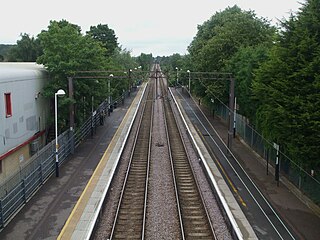
The Chingford branch line is a railway line between Clapton Junction and Chingford station. Services operate between Liverpool Street station and Chingford. The branch is part of the London Overground.
The Great Northern and Great Eastern Joint Railway, colloquially referred to as "the Joint Line" was a railway line connecting Doncaster and Lincoln with March and Huntingdon in the eastern counties of England. It was owned jointly by the Great Northern Railway (GNR) and the Great Eastern Railway (GER). It was formed by transferring certain route sections from the parent companies, and by the construction of a new route between Spalding and Lincoln, and a number of short spurs and connections. It was controlled by a Joint Committee, and the owning companies operated their own trains with their own rolling stock. The Joint Line amounted to nearly 123 miles (198 km) of route.
The Hainault Loop was originally opened as the Fairlop Loop, a 6.5-mile (10.5 km) branch line of the Great Eastern Railway (GER). It once connected Woodford on the Ongar branch to Ilford on the Main Line, with an eastward connection for goods, excursions and stock transfers to Seven Kings. The loop opened to freight on 20 April 1903 and to passengers on 1 May 1903. In 1923, the GER was "grouped" into the London & North Eastern Railway (LNER), who provided passenger services until December 1947. After this date, the route was electrified for London Underground services from both the Woodford and Leytonstone directions, the link to Ilford closed, and today it forms the greater part of the Hainault Loop on the Central line, having been served by Tube trains since 1948.
The Bishop's Stortford–Braintree branch line was an 18-mile-long (29 km) railway line connecting existing railways at Bishop's Stortford, Dunmow and Braintree. It was promoted independently by the Bishop’s Stortford, Dunmow and Braintree Railway (BSD&BR) company, but the directors failed to generate subscriptions, or to manage the construction properly. The Great Eastern Railway was the dominant railway company in the area, and saw the line as a blocker, to prevent the incursion of a rival line, so they felt obliged to support it. However they themselves had other pressing priorities, both managerial and financial, at the time, and for some time the construction was in abeyance.

Wisbech East was a railway station in Wisbech, Cambridgeshire. It was opened in 1848 and became part of the Great Eastern Railway network, providing connections to March, Watlington and St Ives, as well as Upwell via the Wisbech and Upwell Tramway. The station closed in 1968 and no trace of it remains today. A freight-only line remains extant as far as a factory based in the station's former goods yard, and a heritage railway based in March is aiming to reinstate services to Wisbech and construct a new station as near as possible to Newbridge Lane crossing.

Bentley railway station, also known as Bentley Junction between 1849 and 1878, was located in Bentley, Suffolk on the Great Eastern Main Line. It opened in 1846 and became a junction in 1847 when the Hadleigh Railway opened. The station was closed in 1966.
Eastrea railway station was a station serving the village of Eastrea, Cambridgeshire on the Great Eastern Railway's line from Ely to Peterborough. The station was situated at the level crossing on the road leading south from the village towards Benwick. Two miles east of the station was Three Horseshoes junction from where the Benwick goods railway headed south to Benwick.
The Eye Branch was a two miles 72 chains long single track branch railway line in Suffolk, England that ran from Mellis railway station on the Great Eastern Main Line to Eye via one intermediate station, Yaxley Halt. It was the shortest railway branch line in East Anglia to enjoy a regular passenger service.

The Southbury Loop is a line linking Edmonton Green, in north-east London, to Cheshunt. It was opened by the Great Eastern Railway in 1891 although initially it was not very successful and was closed to passenger traffic in 1909. Goods trains continued to use the line although in World War I passenger services were reinstated for munitions workers. Once the war finished the line returned to its goods-only role although was occasionally used for diversionary purposes when the West Anglia Main Line was closed south of Cheshunt. Electrification of the line and the reintroduction of passenger services in 1960 saw the line become busy with regular suburban services as part of the Lea Valley Lines network. Since May 2015 passenger services on the line are part of London Overground.

Turves is a village in the civil parish of Whittlesey, Fenland District, Cambridgeshire, England. It lies east of the town of Whittlesey, south of the A605 road and the Twenty Foot River, and on the Ely–Peterborough line railway between Whittlesey and March, with a level crossing in the village. The local council describes it as "a quiet residential area on the back road between March and Whittlesey".
